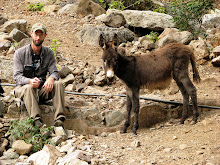The day after our adventure on the river, we found a place to rent a small motorbike in Luang Nam Tha. It was ridiculously cheap at 40,000 kip (~$4.50) a day, so we headed out of town in several directions to see the countryside. Alright, I admit it.... it didn't start out as smoothly as I want to make it sound. You see, I'd never driven a motorcycle before. The very poor directions I received from the guy renting the bikes (language barrier, you see) helped a little, but it took some practice to make it work somewhat well. Everyone around here zips around on these things like they've been driving them since they were 3 (and some have been), but for a big clumsy foreigner it was a little different. Anyway, I eventually got the hang of it, and off we went. Sarah is very trusting.... =)

Matt! at Wat Ban Vieng Tai, Luang Nam Tha
We checked out several of the nearby Wats (Buddhist temples). They are usually placed in a prominent location on a hill, so they have great views of the surrounding area. The second Wat we visited, That Phum Phuk, had an awesome long staircase with dragons for each hand rail -- head at the bottom and tail at the top. We spent a long time up there looking out over the rice paddies and fields. The clouds building behind us finally started some pretty ominous rumbling, so we booked it back the 10 kilometers to town anticipating some rain. We were disappointed in that respect, but it turned out to be a beautiful evening.
One of the best things about Laos so far has been the lack of traffic. I walked along the main highway yesterday for 30 minutes and wasn't passed by a single car or truck -- only a couple bikes. It really is amazing, especially after countries like China and most Latin American countries where the traffic is non-stop, scary, and doesn't pay attention to pedestrians. So Laos seemed like a good place to rent the bike for that reason, too.

Cruisin' in Laos


Wat That Phum Phuk

Yesterday was a big travel day, so not much to report there. We missed the direct bus to Luang Prabang (it left 45 minutes early -- go figure), so we had to wait around for 3 hours for another bus going to a stop a few hours down the road and then catch another from there. The ride was supposed to take 10 - 11 hours, but only covered a ridiculously short distance on the map. Once we got underway it was easy to see why. We were on the main highway, which was a paved road only in the vaguest of sense -- a little bit of pavement every once in a while, otherwise all huge potholes and rocks. Plus, the bus had no shocks and we were sitting in the back. We almost hit the roof a couple of times! Always an adventure in places like this.... Needless to say, we were glad to get out of that bus. The second bus was equally bad, but the road was a tad better and we were able to drive faster.
We didn't arrive in Luang Prabang until about 11pm, so we've spent most of today hanging out and walking around. I'll write more about this beautiful town tomorrow or the next day.
Oh! I added a few photos to the posts on Dali, China and River Runnin'. Check 'em out!
Later!
Matt!





































